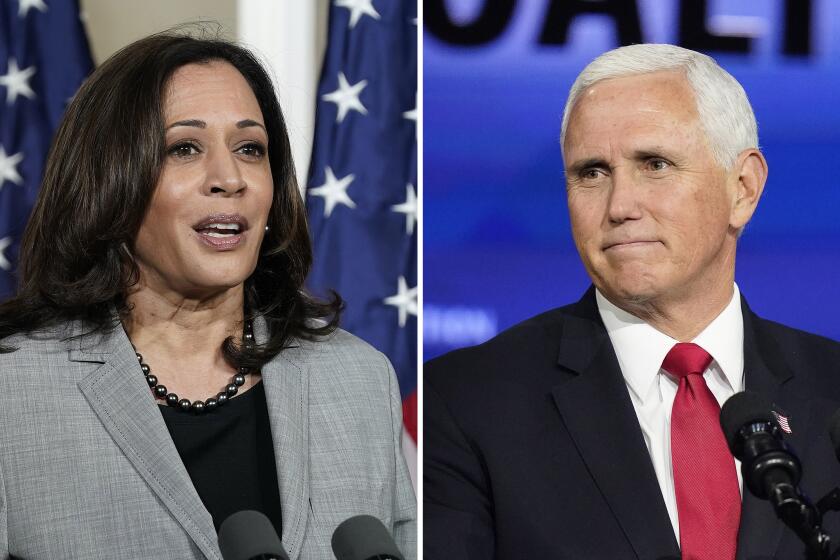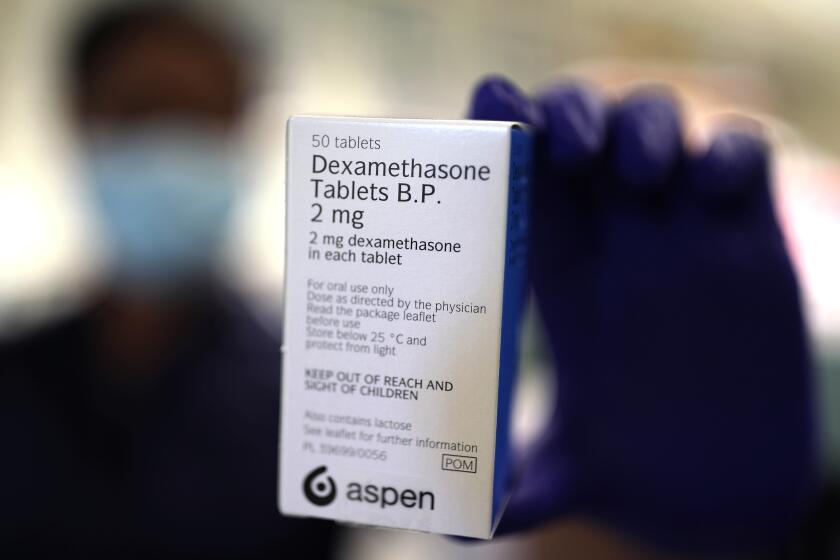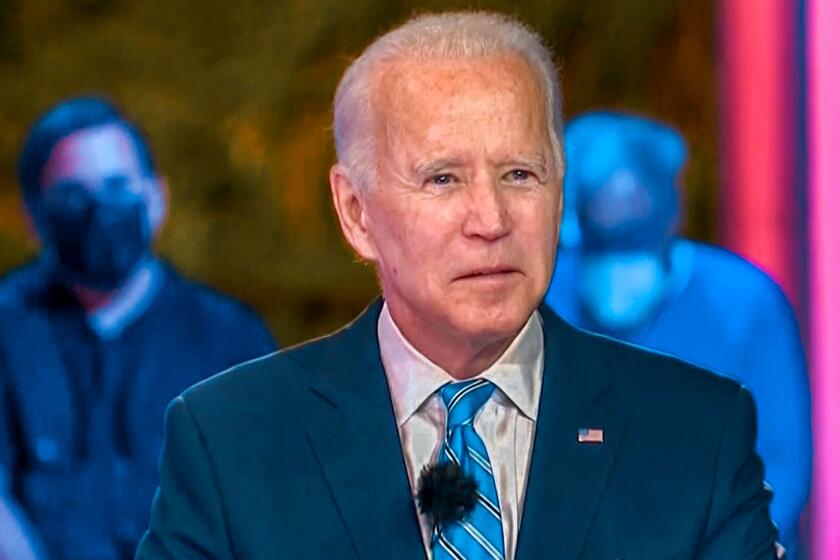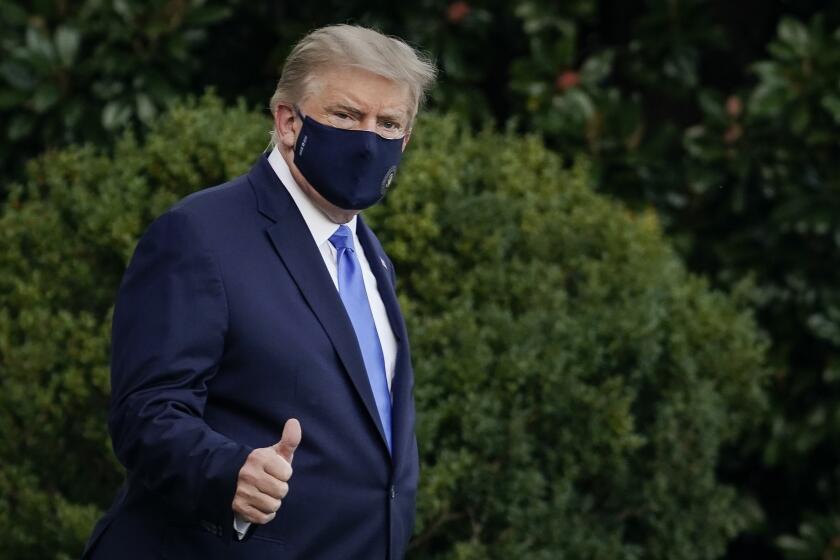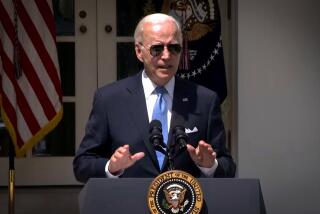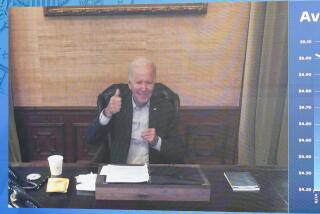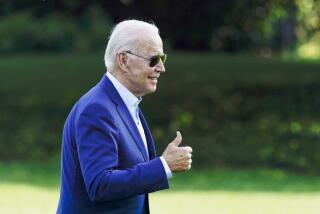Eager to get back on campaign trail, President Trump offers false claims on COVID-19 as he recovers
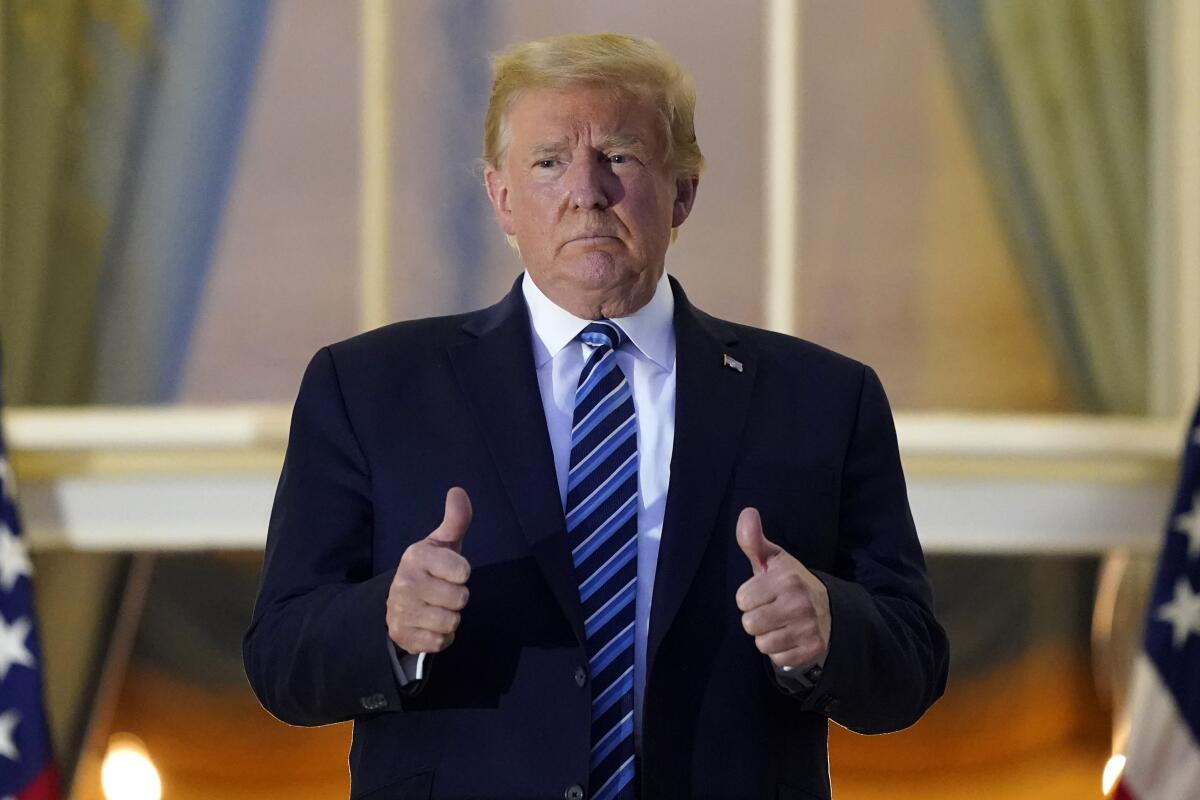
WASHINGTON — Still sickened by COVID-19, President Trump plunged back on Tuesday into downplaying the disease that hospitalized him for three days, one that has, so far, killed more than 210,000 Americans. He compared it anew to the seasonal flu and signaled he planned to return soon to the campaign trail.
Back at the White House after a dramatic helicopter return from the military hospital where he was receiving an unprecedented level of care for COVID-19, Trump’s attitude alarmed infectious disease experts. And it suggested his own illness had not caused him to rethink his often-cavalier attitude toward the disease, which has also infected the first lady and more than a dozen White House aides and associates.
Anxious to project strength just four weeks from election day, Trump, who is still contagious with the virus, tweeted Tuesday morning that he was planning to attend next week’s debate with Democrat Joe Biden in Miami. “It will be great!” he said.
Trump’s doctors have not provided an update on his condition since Monday afternoon, shortly before his departure from Walter Reed National Military Medical Center. His physician, Navy Cmdr. Sean Conley, offered then that the president would not be fully “out of the woods” for another week.
Trump returned to the White House on Monday night aboard Marine One, gingerly climbing the South Portico steps before removing his mask and giving a double thumbs-up from the terrace, where aides had arranged American flags for the sunset occasion. He entered the White House, where aides were visible milling about the Blue Room, without wearing a face covering.
Debate planners add precautions for the Kamala Harris-Mike Pence matchup as White House staff and Republican officials test positive.
In a video released later, Trump offered a nonchalant take on the virus, contravening the public health warnings of his own administration that Americans take the threat seriously and to take precautions to avoid contracting and spreading the disease as cases continue to spike across the country
“Don’t be afraid of it,” Trump said. “You’re going to beat it. We have the best medical equipment, we have the best medicines.” His remarks were strong, but he was taking deeper breaths than usual as he delivered them.
Left unsaid was that the president’s experience with the disease was far from typical, as his doctors rushed him onto experimental antiviral drugs and prescribed an aggressive course of steroids that would be unavailable to the average patient. While most must cope with their symptoms — and fear of whether they’ll take a turn for the worse — at home and alone, Trump had been staying in the presidential suite of one of the nation’s best hospitals, and he’s now at the White House, where there is a team of doctors on call with 24-hour monitoring.
On Tuesday, Trump also returned to his previous comparisons of COVID-19 to the seasonal flu.
“Many people every year, sometimes over 100,000, and despite the Vaccine, die from the Flu,” he tweeted. “Are we going to close down our Country? No, we have learned to live with it, just like we are learning to live with Covid, in most populations far less lethal!!!”
Acknowledging that tiny particles that linger in the air can spread the coronavirus, the U.S. Centers for Disease Control and Prevention warned the public to avoid crowded, poorly ventilated rooms.
In fact, COVID-19 has already proved to be a more potent killer, particularly among older populations, than seasonal flu, and has shown indications of having long-term effects on the health of younger people it infects.
Just days before, Trump suggested he had finally grasped the true nature of the virus, saying in a video, “I get it,” moments before he ventured out of the hospital while contagious to salute cheering supporters by motorcade — an outing that disregarded precautions meant to contain the virus.
Trump’s efforts to play down the threat of the virus in hopes of propping up the economy ahead of the election have drawn bipartisan criticism.
Trump’s doctors treated his COVID-19 with corticosteroid drug dexamethasone. That suggests his early response to the coronavirus spurred serious worry.
Republican Sen. John Cornyn of Texas told the Houston Chronicle editorial board that Trump had “let his guard down” in his effort to show that the country was moving beyond the virus and had created “confusion” about how to stay safe.
“We have to be realistic in this: COVID is a complete threat to the American population,” Dr. David Nace of the University of Pittsburgh Medical Center, said of Trump’s comment.
“Most of the people aren’t so lucky as the president,” with an in-house medical unit and access to experimental treatments, added Nace, an expert on infections in older adults.
“It’s an unconscionable message,” agreed Dr. Sadiya Khan of Northwestern University Feinberg School of Medicine. “I would go so far as to say that it may precipitate or worsen spread.”
Democratic presidential nominee Joe Biden holds a televised town hall as Trump tried to downplay his own COVID-19 case following hospitalization.
Likewise, Biden, who spent more than 90 minutes on the debate stage with Trump last week, said during an NBC town hall Monday night that he was glad Trump seemed to be recovering well, “but there’s a lot to be concerned about — 210,000 people have died. I hope no one walks away with the message that it’s not a problem.” Biden tested negative for the virus on Sunday.
Biden said he’d “listen to the science” ahead of the upcoming debates, adding that the campaigns and the debate commission should be “very cautious” in making plans. “If scientists say that it’s safe, that distances are safe, then I think that’s fine,” he said. “I’ll do whatever the experts say.”
Conley said that because of Trump’s unusual level of treatment so early after discovery of his illness he was in “uncharted territory.” But the doctor also was upbeat at an afternoon briefing and said the president could resume his normal schedule once “there is no evidence of live virus still present.”
According to the Centers for Disease Control and Prevention, those with mild to moderate symptoms of COVID-19 can be contagious for as many as — and should isolate for at least — 10 days.
Trump’s arrival back at the White House raised new questions about how the administration was going to protect other officials from a disease that remained rampant in the president’s body. Press secretary Kayleigh McEnany announced she had tested positive for the virus Monday morning and was entering quarantine.
When President Trump said he had tested positive for the coronavirus, he became ground zero for the most high-profile contact-tracing effort of the pandemic.
There were also lingering questions about potential long-term effects to the president — and even when he first came down with the virus.
Conley repeatedly declined to share results of medical scans of Trump’s lungs, saying he was not at liberty to discuss the information because Trump did not waive doctor-patient confidentiality on the subject. COVID-19 has been known to cause significant damage to the lungs of some patients. Conley also declined to share the date of Trump’s most recent negative test for the virus — a critical point for contact tracing and understanding where Trump was in the course of the disease.
At the hospital, doctors revealed that his blood oxygen level had dropped suddenly twice in recent days and that they gave him a steroid typically only recommended for the very sick.
Trump left the hospital after receiving a fourth dose of the antiviral drug remdesivir Monday evening, Conley said. He will receive the fifth and final dose Tuesday at the White House.
Vice President Mike Pence returned to the campaign trail moments after Trump announced he would soon leave the hospital. The vice president boarded Air Force Two to fly to Salt Lake City, where he is to face off against Democratic vice presidential nominee Sen. Kamala Harris on Wednesday.
More to Read
Get the L.A. Times Politics newsletter
Deeply reported insights into legislation, politics and policy from Sacramento, Washington and beyond. In your inbox three times per week.
You may occasionally receive promotional content from the Los Angeles Times.
